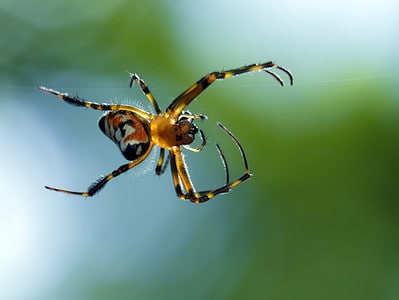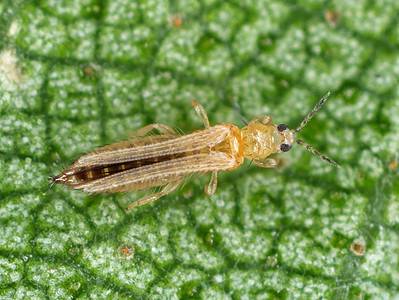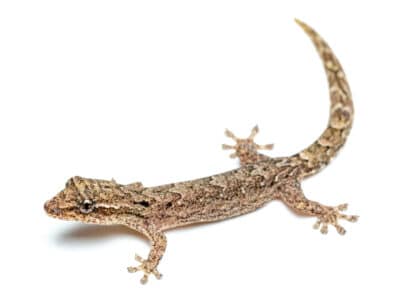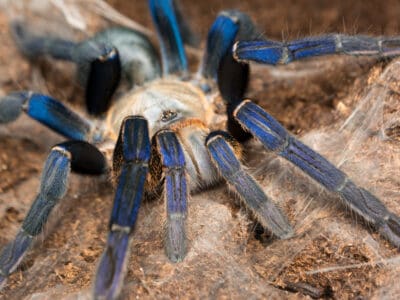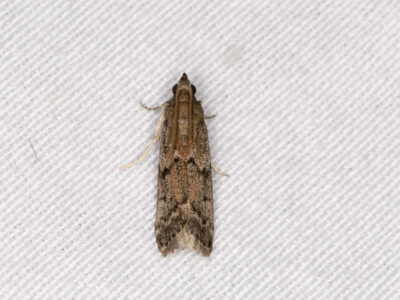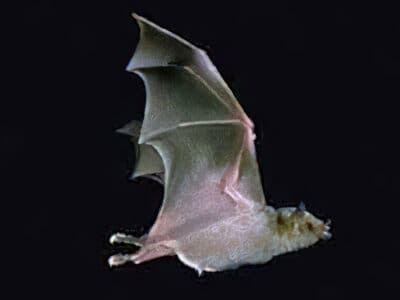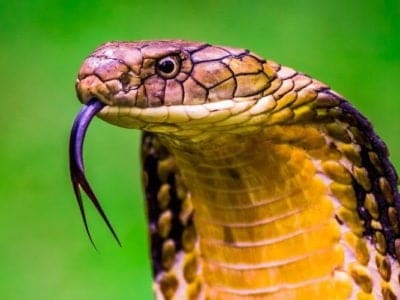White-shouldered House Moth
Endrosis sarcitrella
The larva is the pest because a fully-grown white-shouldered house moth cannot feed; it can only absorb liquid
Advertisement
White-shouldered House Moth Scientific Classification
- Kingdom
- Animalia
- Phylum
- Arthropoda
- Class
- Insecta
- Order
- Lepidoptera
- Family
- Oecophoridae
- Genus
- Endrosis
- Scientific Name
- Endrosis sarcitrella
Read our Complete Guide to Classification of Animals.
White-shouldered House Moth Conservation Status
White-shouldered House Moth Locations
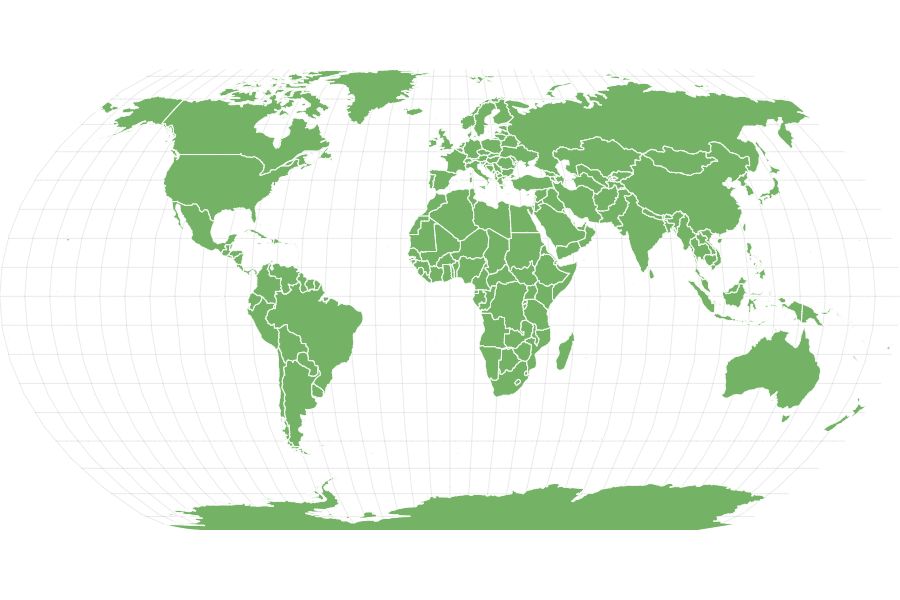
White-shouldered House Moth Facts
- Name Of Young
- Larvae
- Group Behavior
- Infestation
- Fun Fact
- The larva is the pest because a fully-grown white-shouldered house moth cannot feed; it can only absorb liquid
- Most Distinctive Feature
- White head
- Other Name(s)
- House moth
- Wingspan
- 0.59 to 0.8 inches
- Average Spawn Size
- 200 eggs
- Habitat
- Bird nests, homes, and warehouses close to a food source
- Predators
- Birds, spiders, beetles, shrews, and parasitic wasps
- Diet
- Omnivore
- Lifestyle
- Nocturnal
- Favorite Food
- Grains
- Common Name
- White-shouldered house moth
- Location
- Worldwide
View all of the White-shouldered House Moth images!
The white-shouldered house moth is easily distinguishable by its distinct white shoulders and prothorax, which is highlighted by its dark forewings.
Their larva survives mainly on dried food goods; however, they occasionally devour clothes and rugs. Strangely, they are a bigger nuisance in Europe compared to the USA, even though they are vastly distributed along the West Coast in states like California.
The larva is the pest because a fully-grown white-shouldered house moth cannot feed; it can only absorb liquid.
White-shouldered House Moth Species, Types, and Scientific Name
These interesting specimens are a species of Gelechiidae moths; other species include:
Peach Twig Borer (Anarsia lineatella)
Peach twig borer is one of the biggest pests of peach, apricot, and nectarines in the state of Utah. During spring, the larva will burrow into and kill new shoots. However, towards the end of summer, the larvae will ruin the fruit by entering it near the stem.
Each year, multiple generations are born. The best prevention method is through insecticide application. However, there are low-toxicity options available as well.
Groundnut Leaf Miner (Aproaerema modicella)
As their name suggests, the groundnut leaf miner is the primary pest of groundnut. Unlike its cousin, the peach twig borer, this tiny moth damages the groundnut in the larval and adult stages of its life.
They have brownish-gray wings and only measure around 0.24 inches in length. The groundnut leaf miner larvae burrow into the leaves and feed on the insides.
At first, short blister-like mines are visible on the upper side of the leaflets. Next, after 5 to 6 days, the larvae emerge from the mine and migrate in groups to nearby forage, where they feed and pupate in the webbed leaves.
The areas in the leaf mined by these tiny creatures soon dry out. Unfortunately, severe infestations often dry out the entire foliage and make the leaves appear burnt.
Tomato Pinworm (Keiferia lycopersicella)
As their name suggests, these little insects attack the leaves and fruits of tomatoes. However, the larva tends to prefer mining the leaves.
At first, the mine is thin and long, but it starts to widen and becomes blotch-shaped after a while. As the larvae age, they typically fold the leaves over themselves or knit two leaves together, where they continue to feed.
However, the most severe damage to the crop is done when the older larvae burrow into the fruit. They derived their names from the small pinholes they leave at the entry point of the fruit, which is often marked by a small number of droppings.
Guatemalan Potato Moth (Tecia solanivora)
Also known as the Central American potato tuber moth, and is one of the most severe and destructive pests of potato crops. The larvae will mine galleries (holes) throughout the potato, which collects food residue, and waste, and they shed skin inside the potato, contaminating it.
An infestation is devastating to the potato crops within the season and can go unnoticed unless the larvae abandon the galleries, leaving behind exit holes. However, Guatemalan potato moths often survive and thrive in storage facilities.
Tomato Leaf Miner (Tuta absoluta)
These little moths are also known as South American tomato moths, and they originate from Peru but have since spread to much of South America.
Unfortunately, these moths started to appear in Spain in 2007 and have become one of the most damaging tomato plant pests in the Mediterranean and other tropical regions of Europe.
They also occur in:
- The Middle East
- India
- Bangladesh
- Africa
- Central America
Scientific Name
The white-shouldered house moth’s scientific name is Endrosis sarcitrella, and it belongs to the order Lepidoptera. This order consists of over 150,000 species around the globe and is easily distinguishable from other moths because the adults’ wings and bodies are covered in tiny scales.
Many members of this order have a curled proboscis, which they use for siphoning nectar and other fluids, and two pairs of wings.
Lepidoptera is divided into two categories, moths and butterflies. While butterflies tend to be diurnal and have clubbed antennae, moths are mainly nocturnal with plumose or straight antennae.
This order is essential to their ecosystems because many of them are pollinators. Humans don’t have much use for them as few species have medical importance and are generally harmless. However, there are several exceptions, such as the buck moth caterpillar, which delivers a painful sting.
However, many species in this order are considered pests of stored grains, crops, and certain fabrics like curtains and rugs.
White-shouldered house moths are members of the family Oecophoridae, also known as Concealer moths. This large family consists of around 7,550 species, and they primarily inhabit faunal regions in Australia.
In addition, there are 10 recognized subfamilies, which include:
- Depressariinae
- Ethmiinae
- Pelepodinae
- Autostichinae
- Xyloryctinae
- Stenomatinae
- Oecophorinae
- Hypertrophinae
- Chimabachinae
- Deuterogoniinae
Appearance: How To Identify White-shouldered House Moth
The white-shouldered house moth is pale golden brown with tiny dark spots and has fine hairs on its wings’ tips, with a wing span ranging from 0.59 to 0.98 inches. They are often mistaken for a brown house moth but have subtle differences like a white head and shoulders.
Their larvae reach lengths of 0.59 inches, and pupae are enclosed in a silky cocoon and light brown in color. They are often found on premises with lots of food like homes or restaurants and are linked to poor hygiene standards. In addition, they ruin textiles and furnishings, and their ideal habitat is bird nests.
Habitat: Where to Find White-shouldered House Moth
While these moths do damage clothes, they are more drawn to light, unlike their cousins, the carpet moth, and webbed clothes moths. They constantly breed all year round, which is why they are abundant in outbuildings, factory environments, and houses where they can access food sources like grains.
However, their habitat of choice is bird nests, and if these nests are located near a home, there is an increased risk they will enter the house and wreak havoc.
Diet: What Do White-shouldered House Moth Eat?
White-shouldered house moths are omnivores and eat a variety of food such as:
- Grain
- Bran
- Flour
- Cereals
- Wool
- Other animal-based fabrics
Life Cycle of the White-shouldered House Moth
These moths lay around 200 eggs near a food source and hatch over 1 to 4 weeks. The larvae are fully grown between 1 to 5 months and will migrate to silk tunnels constructed in the food particles. It takes a month to morph into adults, and they will live for 2 to 3 weeks.
Prevention: How to Get Rid of White-shouldered House Moth
Getting rid of white-shouldered house moths is very similar to dealing with other house moth species. First, the premises should be thoroughly cleaned with a vacuum, along with any carpets, wardrobes, or drawers.
Stored clothing, textiles, and blankets need checking regularly. If an infestation is found, most moth-killing deterrents or natural alternatives will get rid of them.
Natural ways to get rid of these moths include:
- Filling sachets with dried lavender and place it in the problematic area
- Dip cotton balls in essential oils and put them in drawers, closets, and boxes
- Store clothing in cedar-lined chests of cupboards
- Fill sachets with a combination of cloves, thyme, and rosemary and place in problematic areas
To prevent them from returning, you must frequently check the insides of cupboards, pantries, and larders. In addition, storing dried food and open packets in airtight containers will discourage them from entering the home.
Up Next
View all 108 animals that start with WWhite-shouldered House Moth FAQs (Frequently Asked Questions)
How do I get rid of moths around my house?
Natural ways to get rid of these moths include:
Fill sachets with dried lavender and place them in the problematic area.
Dip cotton balls in essential oils and put them in drawers, closets, and boxes.
Store clothing in cedar-lined chests of cupboards.
Fill sachets with a combination of cloves, thyme, and rosemary and place them in problematic areas.
Do clothes moths fly around the house?
Yes, they usually fly around the area that is infested in a home.
Where do moths nest in a house?
They constantly breed all year round, which is why they are abundant in outbuildings, factory environments, and houses where they can access food sources like grains.
Thank you for reading! Have some feedback for us? Contact the AZ Animals editorial team.
Sources
- Moth Prevention, Available here: https://www.moth-prevention.com/blogs/the-art-of-prevention/white-shouldered-house-moth
- UK Moths, Available here: https://www.ukmoths.org.uk/species/endrosis-sarcitrella/
- Wikipedia, Available here: https://en.wikipedia.org/wiki/White-shouldered_house_moth#
- Butterfly Conservation, Available here: https://butterfly-conservation.org/moths/white-shouldered-house-moth
- Museum Pests, Available here: https://museumpests.net/wp-content/uploads/2019/03/Whiteshouldered-House-Moth.pdf
- Nature Spot, Available here: https://www.naturespot.org.uk/species/white-shouldered-house-moth






